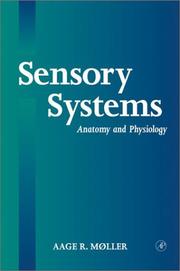| Listing 1 - 4 of 4 |
Sort by
|

ISBN: 1423742699 9781423742692 9780125042574 0125042574 1281033359 9781281033352 9786611033354 6611033351 0080517005 9780080517001 Year: 2003 Publisher: Amsterdam Boston Academic Press
Abstract | Keywords | Export | Availability | Bookmark
 Loading...
Loading...Choose an application
- Reference Manager
- EndNote
- RefWorks (Direct export to RefWorks)
This book provides a comprehensive description of how human sensory systems function, with comparisons of the five senses and detailed descriptions of the functions of each of them. In addition to describing anatomy and function, the book also provides insight as to how sensory information is processed in the brain to provide the basis for communication and for our perception of our surroundings. The information is presented in a way that is suitable for individuals from diverse disciplines and educational backgrounds. It gives the clinician an understanding of the function of normal a
Senses and sensation. --- Sensory neurons. --- Neurotransmitter receptors.

ISBN: 0121852873 9780121852870 1483288331 Year: 1994 Publisher: San Diego, California ; London, England : Academic Press Inc.,
Abstract | Keywords | Export | Availability | Bookmark
 Loading...
Loading...Choose an application
- Reference Manager
- EndNote
- RefWorks (Direct export to RefWorks)
Because of the highly significant and widely recognized roles of ion channels in physiology, pathophysiology, pharmacology, and toxicology, the term ion channel has now become a household word in the biomedical sciences. This volume covers preparations and techniques for the study of various ion channels. Both voltage-gated and ligand-gated ion channels of neurons, axons, and cardiac and smooth muscles are covered. It includes not only patch clamp techniques but molecular biology and imaging techniques as well.Key Features* Comprehensive protocols included for the study of: * I
Electrophysiology --- Ion channels --- Muscle cells. --- Neurons. --- Physiology.
Multi
ISBN: 9783031150807 9783031150791 Year: 2022 Publisher: Cham Springer International Publishing
Abstract | Keywords | Export | Availability | Bookmark
 Loading...
Loading...Choose an application
- Reference Manager
- EndNote
- RefWorks (Direct export to RefWorks)
This handbook is a reference source for identifying, characterizing, instructing on use, and describing outcomes of neurotoxin treatments – to understand mechanisms associated with toxin use; to project outcomes of neurotoxin treatments; to gauge neurotoxins as predictors of events leading to neurodegenerative disorders and as aids to rational use of neurotoxins to model disease entities. Neuroprotection is approached in different manners including those 1) afforded by therapeutic agents – clinical and preclinical; or 2) by non-drug means, such as exercise. The amorphous term ‘neurotoxin’ is discussed in terms of the possible eventuality of a neuroprotectant producing an outcome of excess neuronal survival and a behavioral spectrum that might produce a dysfunction – akin to a neurotoxin’s effect. This new edition significantly expands on the information provided in the first edition, providing the latest research in neurotoxicity and highlighting the relationship between specific neurotoxins and the neurodegenerative disorders they can cause. It also includes new sections on the neurotoxicity of heavy metals, fungi, and snake venom. The Handbook of Neurotoxicity is thus an instructive and valuable guide towards understanding the role of neurotoxins/neurotoxicity in the expansive field of Neuroscience, and is an indispensable tool for laboratory investigators, neuroscientists, and clinical researchers.
General biochemistry --- Physiology of nerves and sense organs --- Toxicology --- neurochemie --- multimedia --- Neurophysiology. --- Neurons. --- Nervous system --- Toxicology. --- Neurochemistry. --- Cellular Neuroscience. --- Neurological Disorders. --- Diseases. --- Neurotoxicologia
Multi
ISBN: 9783031496813 9783031496806 9783031496820 9783031496837 3031496817 Year: 2023 Publisher: Cham : Springer Nature Switzerland : Imprint: Springer,
Abstract | Keywords | Export | Availability | Bookmark
 Loading...
Loading...Choose an application
- Reference Manager
- EndNote
- RefWorks (Direct export to RefWorks)
Exposure of patients to a high oxygen environment is a standard treatment in a select group of patients. The development of oxygen toxicity must be avoided in those patients. This book describes the effects of normobaric and hyperbaric oxygen treatment of animal models on brain biochemical and physiological responses. This book provides a summary of our knowledge on the effects of hyperbaric oxygenation on mitochondrial activity in vivo, and other functions of the brain. A chapter covering the use of hyperbaric hyperoxia in patients’ brain pathology and care is also included. This is an ideal book for students, research groups, and clinicians studying hyperbaric oxygen and its connection to mitochondrial activity and brain physiological functions.
Histology. Cytology --- Physiology of nutrition. Metabolism --- Toxicology --- Neuropathology --- neurologie --- multimedia --- cytologie --- histologie --- stofwisseling --- Neurophysiology. --- Neurons. --- Toxicology. --- Neurosciences. --- Metabolism. --- Cytology. --- Cellular Neuroscience. --- Neuroscience. --- Cell Biology.
| Listing 1 - 4 of 4 |
Sort by
|

 Search
Search Feedback
Feedback About UniCat
About UniCat  Help
Help News
News